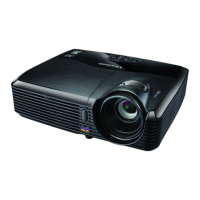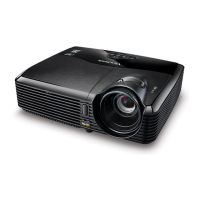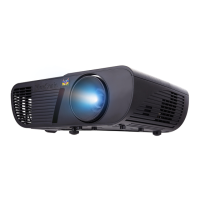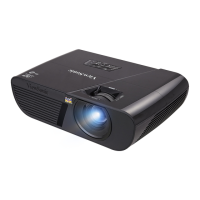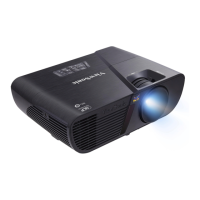Connection14
Many notebooks do not turn on their external video ports when connected to a projector.
Usually a key combo like FN + F3 or CRT/LCD key turns the external display on/off. Locate a
function key labeled CRT/LCD or a function key with a monitor symbol on the notebook. Press
FN and the labeled function key simultaneously. Refer to your notebook's documentation to
find your notebook's key combination.
Connecting a monitor
If you want to view your presentation close-up on a monitor as well as on the screen, you
can connect the COMPUTER OUT signal output socket on the projector to an external
monitor with a VGA cable following the instructions below:
To connect the projector to a monitor:
1. Connect the projector to a computer as described in "Connecting a computer" on page
13.
2. Take a suitable VGA cable (only one supplied) and connect one end of the cable to the
D-Sub input socket of the video monitor.
Or if your monitor is equipped with a DVI input socket, take a VGA to DVI-A cable
and connect the DVI end of the cable to the DVI input socket of the video monitor.
3. Connect the other end of the cable to the COMPUTER OUT socket on the projector.
The final connection path should be like that shown in the following diagram:
• The COMPUTER OUT output only works when COMPUTER IN 1 or COMPUTER IN 2 is
made to the projector.
• If you wish to use this connection method when the projector is in standby mode, make
sure the Active VGA Out function is turned on in the SYSTEM SETUP: Advanced menu.
See "Active VGA Out" on page 38 and the table below for details.
Notebook or desktop
computer
VGA cable
VGA cable
VGA to DVI-
A cable
or
Monitor
Active VGA Out status
Projector status
Power On Standby
On (Default)
Active connector: *COMPUTER
IN 1/*COMPUTER IN 2/
COMPUTER OUT/AUDIO IN/
AUDIO OUT
Active connector: COMPUTER
IN 1
/COMPUTER OUT/AUDIO
IN/AUDIO OUT
Off
N/A N/A
* The signal being displayed from COMPUTER OUT port depends on which signal
(COMPUTER IN 1 or COMPUTER IN 2) is selected for the projector.

